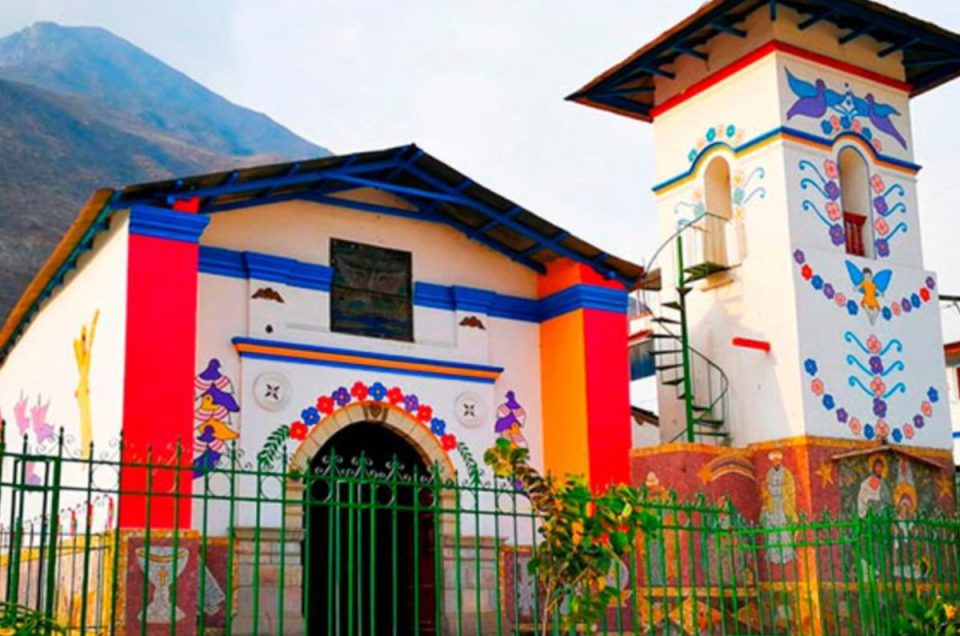Antioquia is famous for its colorful churches, houses and streets, which earned it the Guinness Record for the “largest altarpiece in the world” in 2007, and is today a very popular destination for tourism near Lima, thanks to its warm climate, tasty gastronomy, archaeological sites and even corners for adventure in the middle of nature. Learn more below.
Currently, the also called ‘magical town of colors’ has more than 120 facades painted white and full of designs similar to those seen in Ayacucho altarpieces, in the form of plants, animals and other figures that take us back to the spring season. But its attractiveness is not limited to that: in the surroundings you can do activities such as camping, trekking, mountain biking, canoeing, canopy and off road motorcycles.
This picturesque story began in 2004, when the inhabitants of this district of the province of Huarochirí looked for another source of income besides agriculture, in an attempt to improve their economy. This is how the project ‘Colors for Antioquía’ by artist Enrique Bustamante, winner of the Center for Research, Education and Development contest, emerged. Under this idea, the facades of houses and premises were decorated with varied colors and motifs.
Where is Antioch?
Antioquía is located 76 kilometers from the center of Lima, in the province of Huarochirí and about 1,500 meters above sea level. This district was founded in 1935 and its capital is the town of Espíritu Santo.
How to get to Antioquia from Lima?
You can get to Antioquía by car or your own vehicle, take the route towards Cieneguilla in the direction of La Molina and continue directly to the province of Huarochirí; or take one of the buses that leave from the intersection of Nicolás Arriola and Rosa Toro avenues, in San Luis. You can also sign up for a full day tour of this magnificent destination. The duration of the trip is about three hours.
Climate in Antioch
One of the best things about Antioch is its climate, warm for most of the year. The best time to visit this charming town is between April and December, when the temperature usually averages 22° C.
Tourist places in Antioch
Below, we show you a list of the best places you can visit in the Antioquía district for a tour full of unforgettable experiences:
Holy Spirit Church
The central temple of the town of Espíritu Santo offers perhaps some of the most memorable postcards of the place, with its façade full of Andean and multicolored designs. This church has inside small altars with golden motifs and a main altar with a large altarpiece.
Local Museum of Antioch
Near the Plaza de Armas you can also find a small but interesting museum with ceramics, ancient utensils and tools, samples of plants and animals, and even mummies.
Cerrito de Amancaes Viewpoint
One of the two viewpoints that Antioquía has. You can climb it from the city, admire the colorful houses along the way and, once at the top, enjoy an unparalleled view of the picturesque town and the green valley that surrounds it.
Cochahuayco
The town of Santiago de Cochahuayco is located 3 kilometers from the town center of Espíritu Santo. You can visit the beautiful Temple of Santiago de Cochahuayco, declared Cultural Heritage of the Nation, as well as the Processing Plant that offers a tour to learn about the agribusiness of the area.
Qhapaq Ñan
In the Santa Rosa de Chontay area you can find one of the best preserved segments of the Xauxa-Pachacamac section of the Inca trail or Qhapaq Ñan. On it you can trek and admire the landscape.
Lurin River
In the area you can also find this river surrounded by greenery. The pools on its banks are ideal for taking a refreshing swim, as long as the waters are calm.
Nieve Nieve archaeological site
Near the small town of San José de Nieve Nieve is this archaeological site that houses houses from the Inca era and even a cemetery. This town also boasts a beautiful stained glass church and a viewpoint for incredible panoramic views.
What to do in Antioch?
I love its tranquility, the only thing I miss is the internet connection, which is very limited (the cell phone signal does not reach well), something that I think has already been solved.
You can go on your own or on a full day tour. There are six things that I recommend you do in Antioch, and if you want to do them all, you need more than one day:
-
Walk through the town to the viewpoint:
Starting with its main square, the church, the community hall, the school and going up to the viewpoint. All along the way, you will see houses decorated with murals. Now it has two viewpoints.
-
Visit the Antioch museum
Small museum with ceramics, utensils and tools. You can also find 2 mummies, among other accessories. Admission costs 3 soles per adult, children do not pay.
-
Visit Cochahuayco
Cochahuayco is another very quiet town just 2.5 km from Espíritu Santo de Antioquía. It has a 17th century church and a small apple and quince jam production plant, which I hope continues to operate.
You can go by car or on foot. It is an easy hike that can be done with children, like my friend from Escápe en Familia did. I also prefer to go on foot and enjoy the scenery.
-
Bathe in the Lurín River pool
As long as the river is not very large. After the walk and the intense sun, we cooled off in the river. The only drawback was the mosquitoes.
-
Trekking through the Qhapac Ñan (Inca trail):
The best of Antioch! I have done the hike twice and loved it. The trekking begins in Cochahuayco, bordering the hills, following a section of the Inca trail that linked Pariacaca with Pachacamac. You pass through some tambos, a desert landscape with very peculiar cacti, you cross the river in oroya and arrive at Antioquía.
It is an easy walk but it lasts three to four hours, depending on the pace and stops. I recommend starting it before 11 am.
-
Delight in the dules of Antioch.
The pumpkin mazamorra sold by the ladies in the Plaza de Espíritu Santo is one of the tastiest I have ever tried.
Quince and guava jams and nectars. Don’t forget to take a pair home.
Handmade ice creams
Why were houses painted with murals?
I really believe that the history of Antioch is a very creative example of how to boost the local economy, which was based on agriculture, with apples as its main product, towards other sectors. Since the 90s, the CIED (Center for Research, Education and Development) worked to promote agricultural development and agro-industrial products; However, they needed to reach a broader market. That is why in 2003, they proposed the strategy of attracting visitors by developing their tourist offer. This is how the “Colors for Antioquia” project emerged, to turn it into a work of art.
The first step was to raise awareness among the population, with plastic arts workshops for adults and children, and with an Art Symposium. They summoned several visual artists, who lived with families from the town, to then paint pictures related to the local identity and exhibit them in a gallery in Antioquía.
The second step was an international contest to choose the artistic design that would be painted in the town, with the winner being the Peruvian painter Enrique Bustamante.
Finally, Antioch was painted in 2004, starting with the school, the church, the communal premises and the renovation of the facades. Rafo León in his Guide to the Lima Region mentions that initially some neighbors were reluctant to paint their facades, because the colors (pink, blue, yellow and lilac) were “very mountainous.” Over time they joined the initiative and to date you can see beautiful murals in most homes.
Machu Picchu Travel Tours
Reserve our guided trips to Machu Picchu by contacting our travel experts and you will be closer to completing your adventure:
- Cusco to Machu Picchu
- Machu Picchu Day Trip
- Machu Picchu Peru
- Machu Picchu tours from Lima
- 2 Day Inca Trail Tour
- Classic Inca Trail Tour
- 3 Day Inca Trail Hike
Book Huayna Picchu Ticket 2024
Book Machu Picchu Mountain Ticket 2024



